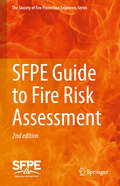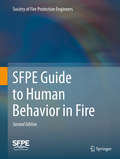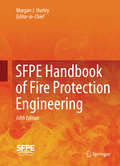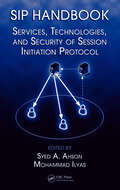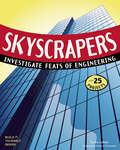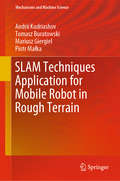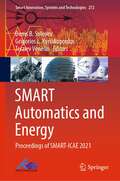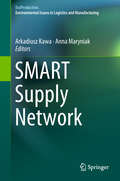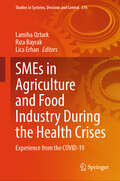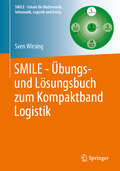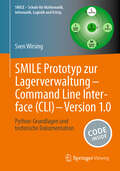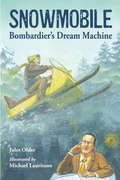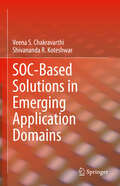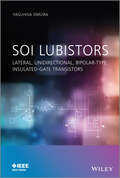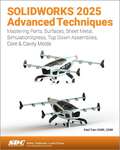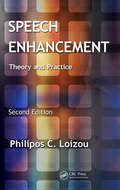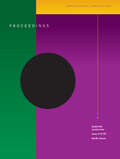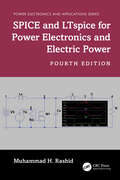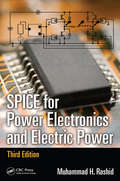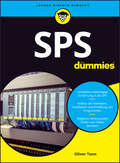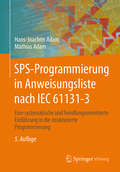- Table View
- List View
SESV - 05 - Manosamajik Ane Koutumbik Samasyao - Kutumbni Samelgiri Ane Sashaktikaran - 3 - BAOU: મનોસામાજિક અને કૌટુંબિક સમસ્યાઓ કુટુંબની સામેલગીરી અને સશક્તિકરણ - ૩
by Babasaheb Ambedkar Open UniversitySESV – 05 મનોસામાજિક અને કૌટુંબિક સમસ્યાઓ કુટુંબની સામેલગીરી અને સશક્તિકરણ – 3.
SFPE Guide to Fire Risk Assessment: SFPE Task Group on Fire Risk Assessment (The Society of Fire Protection Engineers Series)
by Austin GuerrazziThe SFPE Guide to Fire Risk Assessment provides guidance to qualified practitioners in developing, selecting, and using fire risk assessment methodologies for the design, construction, and operation of buildings, facilities, or processes. It also addresses fire risk acceptability, the role of fire risk assessment and fire risk management in the fire safety design process, and associated communication/ monitoring of fire risk. The guide Includes a new flow chart that outlines the risk assessment process. It also includes new information related to: Risk PerceptionF-N curvesRisk communicationResidual risk managementRisk monitoringSensitivity analysis The guide also provides clear guidance on conducting qualitative and quantitative analysis. It also uses examples that reinforce topics discussed.
SFPE Guide to Human Behavior in Fire
by Society of Fire Protection EngineersThis single resource for the fire safety community distills the most relevant and useful science and research into a consensus-based guide whose key factors and considerations impact the response and behavior of occupants of a building during a fire event.The Second Edition of SFPE's Engineering Guide: Human Behavior in Fire provides a common introduction to this field for the broad fire safety community: fire protection engineers/fire safety engineers, human behavior scientists/researchers, design professionals, and code authorities. The public benefits from consistent understanding of the factors that influence the responses and behaviors of people when threatened by fire and the application of reliable methodologies to evaluate and estimate human response in buildings and structures.This Guide also aims to lessen the uncertainties in the "people components" of fire safety and allow for more refined analysis with less reliance on arbitrary safety factors. As with fire science in general, our knowledge of human behavior in fire is growing, but is still characterized by uncertainties that are traceable to both limitation in the science and unfamiliarity by the user communities. The concepts for development of evacuation scenarios for performance-based designs and the technical methods to estimate evacuation response are reviewed with consideration to the limitation and uncertainty of the methods. This Guide identifies both quantitative and qualitative information that constitutes important consideration prior to developing safety factors, exercising engineering judgment, and using evacuation models in the practical design of buildings and evacuation procedures. Besides updating material in the First Edition, this revision includes new information on:Incapacitating Effects of Fire Effluent & Toxicity Analysis MethodsOccupant Behavior ScneariosMovement Models and Behavioral ModelsEgress Model Selection, Verification, and ValidationEstimation of Uncertainty and Use of Safety FactorsEnhancing Human Response to Emergencies & Notification of MessagingThe prediction of human behavior during a fire emergency is one of the most challenging areas of fire protection engineering. Yet, understanding and considering human factors is essential to designing effective evacuation systems, ensuring safety during a fire and related emergency events, and accurately reconstructing a fire.
SFPE Handbook of Fire Protection Engineering
by John R. Hall Morgan J. Hurley Daniel Gottuk Kazunori Harada Erica Kuligowski Milosh Puchovsky José Torero John M. Watts Christopher WieczorekRevised and significantly expanded, the fifth edition of this classic work offers both new and substantially updated information. As the definitive reference on fire protection engineering, this book provides thorough treatment of the current best practices in fire protection engineering and performance-based fire safety. Over 130 eminent fire engineers and researchers contributed chapters to the book, representing universities and professional organizations around the world. It remains the indispensible source for reliable coverage of fire safety engineering fundamentals, fire dynamics, hazard calculations, fire risk analysis, modeling and more. With seventeen new chapters and over 1,800 figures, the this new edition contains: * Step-by-step equations that explain engineering calculations * Comprehensive revision of the coverage of human behavior in fire, including several new chapters on egress system design, occupant evacuation scenarios, combustion toxicity and data for human behavior analysis * Revised fundamental chapters for a stronger sense of context * Added chapters on fire protection system selection and design, including selection of fire safety systems, system activation and controls and CO2 extinguishing systems * Recent advances in fire resistance design * Addition of new chapters on industrial fire protection, including vapor clouds, effects of thermal radiation on people, BLEVEs, dust explosions and gas and vapor explosions * New chapters on fire load density, curtain walls, wildland fires and vehicle tunnels * Essential reference appendices on conversion factors, thermophysical property data, fuel properties and combustion data, configuration factors and piping properties.
SIP Handbook: Services, Technologies, and Security of Session Initiation Protocol
by Mohammad Ilyas Syed A. AhsonWidely adopted by service providers to enable IP telephony, instant messaging, and other data services, SIP is the signaling protocol of choice for advanced multimedia communications signaling. Compiled by noted engineering experts Syed Ahson and Mohammad Ilyas, SIP Handbook: Services, Technologies, and Security of Session Initiation Protocol presents a thorough technical review of all aspects of SIP. It captures the current state of IP Multimedia Subsystem technology and provides a unique source of comprehensive reference material on this subject. SIP Applications for Today and Tomorrow The scope of this volume ranges from basic concepts to future perspectives. Divided into three sections, the book begins with a discussion of SIP in peer-to-peer networks and then goes on to examine advanced media integration, migration considerations, mobility management, and group conferencing, while also reviewing home networking and compliance issues. The middle section of the book focuses on the underlying technologies of SIP. Chapters review network architecture, vertical handoffs, NAT traversals, multipoint extensions, and other areas at the forefront of research. Finally, the text examines various security vulnerabilities and provides perspectives on secure intelligent SIP services with a future outlook on a fraud detection framework in VoIP networks. Insights from International Researchers Authored by 65 experts from across the world, this text is sure to advance the field of knowledge in this ever-changing industry and provide further impetus for new areas of exploration. Because of the editors’ pivotal influence and their proximity to both the current market and the latest science, this work is certain to become the definitive text on this emerging technology.
SKYSCRAPERS
by Andrew Christensen Donna LathamOver centuries and across cultures people have defied gravity in a quest to build the tallest, grandest structures imaginable.Skyscrapers: Investigate Feats of Engineering with 25 Projects invites children ages 9 and up to explore the innovation and physical science behind these towering structures. Trivia and fun facts illustrate engineering ingenuity and achievements from the ancient pyramids to the Empire State Building. Readers will develop an understanding of how our modern, sophisticated building techniques and materials evolved over time.Activities and projects encourage children to explore the engineering design process. They will engage in hands-on explorations of wind, test Newton's laws of motion, and experiment with the strength of different shapes. In the process they will learn about gravity, inertia, oscillation, and static electricity. Using various materials and engaging in trial and error, readers will construct their own towers and skyscrapers. Skyscrapers meets common core state standards in language arts for reading informational text and literary nonfiction and is aligned with Next Generation Science Standards. Guided Reading Levels and Lexile measurements indicate grade level and text complexity.
SLAM Techniques Application for Mobile Robot in Rough Terrain (Mechanisms and Machine Science #87)
by Mariusz Giergiel Tomasz Buratowski Piotr Małka Andrii KudriashovThis book presents the development of SLAM-based mobile robot control systems as an integrated approach that combines the localization, mapping and motion control fields, and reviews several techniques that represent the basics of the mathematical description of wheeled robots, their navigation and path planning approaches, localization and map creating techniques. It examines SLAM paradigms and Bayesian recursive state and map estimation techniques, which include Kalman and particle filtering, and enable the development of a SLAM-based integrated system for the inspection task performed. The system’s development is divided into two phases: a single-robot approach and multirobot inspection system. The book describes an original approach to 2D SLAM in multi-floor buildings that covers each 2D level map, as well as continuous 3D pose tracking, and views the multirobot inspection system as a group of homogeneous mobile robots. The last part of the book is dedicated to multirobot map creation and the development of path planning solutions, which allow the robots’ homogeneous behavior and configuration to be used to develop a multirobot system without theoretical limitations on the number of robots used.
SMART Automatics and Energy: Proceedings of SMART-ICAE 2021 (Smart Innovation, Systems and Technologies #272)
by Denis B. Solovev Grigorios L. Kyriakopoulos Terziev VenelinThis book gathers selected papers presented at the International Conference on SMART Automatics and Energy (SMART-ICAE 2021), held in Far Eastern Federal University, Vladivostok, Russian Federation during 7–8 October 2021. The book will be useful for wide range of specialists in the field of designing innovative solutions and organizational measures that increase the efficiency of the use of industry technologies in their various manifestations. The issue is also of interest to scientific and engineering personnel engaged in the achievements and farsighted researches in the area of intellectual technology use for solving of real, applied tasks in various areas of industries and policies of nations and systems and for students and undergraduates studying “Power systems engineering and electrotechnics”, “Automatized systems”, “Managerial systems in power technologies”, etc., and postgraduate students in the corresponding branches of study.
SMART Integrated Circuit Design and Methodology (River Publishers Series in Tutorials in Electronic Materials, Circuits, and Devices)
by Costas Psychalinos Alkis HatzopoulosThis book describes advanced flows and methodologies for the design and implementation of system-on-chip (SoC). It is written by a mixture of industrial experts and key academic professors and researchers. The intended audience is not only students but also engineers with system-on-chip and semiconductor background currently working in the semiconductor industry. Integrated Circuits are available in every electronic product, especially in emerging market segments such as 5G mobile communications, autonomous driving, fully electrified vehicles, and artificial intelligence. These product types require real-time processing at billions of operations per second. The development design cycle time is driving costs and time to market more than ever before. The traditional design methodologies have reached their limits and innovative solutions are essential to serve the emerging SoC design challenges. In the framework of the Circuit and System Society (CASS) Outreach Initiative 2022 call, the SMART Integrated Circuits design methodology – named SMARTIC – Seasonal School was performed in November 2022, in Thessaloniki (Greece). Features Core analog circuits of any system of chip, such as high-performance rectifiers and filters, are addressed in detail, together with their respective design methodology. New advanced methodologies towards design cycle speed up based on machine learning and artificial intelligence applications. Advanced analog design methodology based on gm/Id and lock up tables. A powerful flow for enabling fast time to market analog circuit design focusing on baseband circuits More exotic methodologies and applications with focus on digital-based analog processing in nanoscale CMOS ICs and the design and development of depleted monolithic active pixel sensors for high-radiation applications, together with all the respective challenges of this application.
SMART Supply Network (EcoProduction)
by Arkadiusz Kawa Anna MaryniakThis book describes approaches, opinions, and concepts for new and emerging solutions and technologies that could be successfully applied in the configuration, optimization and management of supply networks in the highly volatile environment of today’s global economy. It features numerous case studies and quantitative research from different sectors and different countries. The authors, which include academics and managers alike, present tips on technical, organizational, financial and social aspects of implementing the new SMART solution. Dynamic and changing market conditions have made it necessary for companies to act in networks to maintain their competitive position. Accordingly, they have to adapt their own actions to those of other market players, which requires a SMART attitude: today’s supply networks need to be Sustainable, Modern, Adaptive, Robust and innovative Technology-oriented. For example, this concerns making decisions about the extent to which a business model should be green or lean. In turn, these decisions impact logistics, IT, environmental issues and co-operation between suppliers, customers, competitors, and complementors.
SMEs in Agriculture and Food Industry During the Health Crises: Experience from the COVID-19 (Studies in Systems, Decision and Control #576)
by Lamiha Ozturk Rıza Bayrak Lica ErhanThis book aims to propose a suitable contingency plan that can minimize the negative effects of future health crises while strengthening the resilience and adaptability of SMEs. The starting point of this work is based on the work of the research project No. 221N283, jointly funded by TÜBİTAK and NARD. This project is part of an integrated approach from the laboratory to the market, with the aim of analyzing and promoting practical and strategic solutions for the development of SMEs in a crisis context. Following the results obtained, the scientific research team sought to broaden its scope of investigation by addressing the challenges that small and medium-sized enterprises (SMEs) face during global crises. This is a crucial issue in a context where economic sustainability and security are increasingly threatened by unforeseen events such as global epidemics.
SMILE - Übungs- und Lösungsbuch zum Kompaktband Logistik (Schule für Mathematik, Informatik, Logistik und Erfolg)
by Sven WirsingDieses Übungsbuch ergänzt den SMILE-Kompaktband mit einer Vielzahl von Übungsaufgaben und deren Lösungen. Alle im Kompaktband dargestellten Inhalte: Grundlagen, Wareneingangskontrolle, Chargenschnittstelle, Kühlguteinlagerung, GUI-Dialoge und Disposition von LKWs werden mit logistischen und mathematischen Aufgaben sowie Fragestellungen zu Python vertieft. Die Python-Lösungen sind bei Springer downloadbar. Ein besonderes Highlight ist das letzte Kapitel Szenario „Tischtennis-AG“, in dem mittels einer fiktiven Firma, die Tischtennis-AG, die wichtigsten Thematiken zu allen Kapiteln erneut als Aufgaben praxisrelevant dargestellt werden.
SMILE Prototyp zur Lagerverwaltung - Command Line Interface: Python-Grundlagen und technische Dokumentation (Schule für Mathematik, Informatik, Logistik und Erfolg)
by Sven WirsingDieses Buch ermöglicht einen Einstieg in die ,Programmiersprache Python&‘. Hierzu werden die zum Verständnis des ,SMILE-CLI-Prototypen&‘ notwendigen ,Python-Grundlagen&‘ allgemein und mittels Beispiele sowie Python-Programmen erläutert. Neben der theoretischen Erarbeitung der wesentlichen Grundlagen erlaubt dies sofort erste praktische Programmiererfahrungen mit Python zu gewinnen. Deshalb stehen alle verwendeten Beispielprogramme auch zum Download bei ,Springer-Link&‘ für Sie bereit und können von Ihnen nach Belieben abgeändert werden. Der Inhalt orientiert sich im ,Grundlagen-Kapitel&‘ an Themen, die zum Verständnis der CLI-Version des SMILE-LVS-Prototypen benötigt werden. Hierzu zählen etwa der Umgang mit dem ,Spyder-Editor&‘, die Arbeit mit ,Paketen&‘, die Unterscheidung von ,Hauptprogramm&‘ und ,Unterprogramm&‘, die Befehle zur Eingabe und Ausgabe in der ,User-Kommunikation&‘, der Umgang mit und das Zuweisen von ,Variablen&‘, die Verwendung von ,Python-Datentypen&‘, das Programmieren logischer Ausdrücke, der Nutzen von Schleifen und Datenstrukturen, die Erzeugung von ,Zeitstempeln&‘ und ,Zufallszahlen&‘, der Umgang mit ,CSV-Dateien&‘, PDF-Dokumenten&‘ und ,QR-Barcodes&‘, der Umgang mit ,Ausnahmebehandlungen&‘, die Klassifikation von ,Bugs&‘, ,Debugging&‘ und ,Bugfixing&‘, die Zugriffe auf ,Pfade und Dateien&‘ sowie der Umgang mit ,Klassen und Methoden&‘. Der zweite Baustein dieses Buches ermöglicht detaillierte Einblicke in die ,Programmierung des CLI-LVS-Prototyps&‘. Zunächst werden die Konzeptionierung und der Ablauf aller Unterprogramme, Klassen und des Hauptprogramms schematisch dargestellt. Es wird detailliert auf die ,Datenbasis in Form von CSV-Dateien&‘ eingegangen, mit der alle notwendigen ,Stamm- und Bewegungsdaten&‘ erfasst, bearbeitet und ausgewertet werden. Nachfolgend wird auf den ,Programmcode des CLI-LVS-Prototyps&‘ eingegangen. Alle ,Unterprogramme&‘, alle ,Klassen&‘ und alle ,Methoden&‘ sowie das ,Hauptprogramm&‘ sind mit ihrem jeweiligen ,Programmcode&‘ aufgeführt. Zum Verständnis des Codes ist in jeder Zeile ein zugehöriger ,Kommentar&‘ hinzugefügt, der die Code-Zeile explizit erläutert. Alle benutzten ,Python-Befehle&‘ sind für jeden Abschnitt aufgelistet.
SNOWMOBILE: Bombardier's Dream Machine
by Jules OlderIn 1922, when Joseph-Armand Bombardier was fifteen years old he built his first snow vehicle. He had always loved to tinker with motors and make things go, and he dreamed of building a vehicle that could go over snow. His first attempt, using a Model T Ford engine and a wooden propeller, worked well. To Joseph-Armand’s mind, anyhow. Not so much his father, who made him take the contraption apart. Over the years, Joseph-Armand dreamed of becoming a great mechanic and inventing machines. But when his young son died of a fever because it was impossible to get to the hospital over the snow-covered roads, Joseph-Armand applied his single-minded determination to building a vehicle that could go over snow. It took years, but he accomplished his goal. His invention changed the way people in snow country lived. Inaccessible roads could now be travelled, taking patients to hospitals, doctors and priests to the needy, children to school, and even mail to residents.
SOC-Based Solutions in Emerging Application Domains
by Veena S. Chakravarthi Shivananda R. KoteshwarWorking in the ever-evolving field of smart chip design within an AI-powered design environment, the authors of this book draw on their experiences in successfully developing system-on-chip (SoC) solutions, having grappled with the emerging design environment, innovative tools, domain-specific challenges, and major design decisions for SOC-based solutions. They present the first comprehensive guide to navigating the technical challenges of SOC-based solutions in emerging application domains, covering various design and development methodologies for system-on-chip solutions for emerging target applications. When diligently applied, the strategies and tactics presented can significantly shorten development timelines, help avoid common pitfalls, and improve the odds of success, especially in AI-powered smart EDA environments. The book provides a detailed insight into SoC-based solutions for various applications, including artificial intelligence (AI), post-quantum security feature enhancements, 3D SOCs, quantum SOCs, photonic SOCs, and SOC solutions for IoT, high-performance computing SOCs, and processor-based systems. The coverage includes architecture exploration methods for targeted applications, compute-intensive SoCs, lightweight SoCs for IOT applications, advanced technology node solutions, and solutions including hardware software co-designs and software-defined SoCs. The strategies best applied in these highly advanced technology developments are discussed in a guest chapter by a practicing high technology strategist so innovators, designers, entrepreneurs, product managers, investors, and executives may properly prepare their companies to succeed.
SOI Lubistors: Lateral, Unidirectional, Bipolar-type Insulated-gate Transistors (Wiley - IEEE)
by Yasuhisa OmuraAdvanced level consolidation of the technology, physics and design aspects of silicon-on-insulator (SOI) lubistors No comprehensive description of the physics and possible applications of the Lubistor can be found in a single source even though the Lubistor is already being used in SOI LSIs. The book provides, for the first time, a comprehensive understanding of the physics of the Lubistor. The author argues that a clear understanding of the fundamental physics of the pn junction is essential to allowing scientists and engineers to propose new devices. Since 2001 IBM has been applying the Lubistor to commercial SOI LSIs (large scale integrated devices) used in PCs and game machines. It is a key device in that it provides electrostatic protection to the LSIs. The book explains the device modeling for such applications, and covers the recent analog circuit application of the voltage reference circuit. The author also reviews the physics and the modeling of ideal and non-ideal pn junctions through reconsideration of the Shockley’s theory, offering readers an opportunity to study the physics of pn junction. Pn-junction devices are already applied to the optical communication system as the light emitter and the receiver. Alternatively, optical signal modulators are proposed for coupling the Si optical waveguide with the pn-junction injector. The book also explores the photonic crystal physics and device applications of the Lubistor. Advanced level consolidation of the technology, physics and design aspects of silicon-on-insulator (SOI) lubistors Written by the inventor of the Lubistor, this volume describes the technology for readers to understand the physics and applications of the device First book devoted to the Lubistor transistor, presently being utilized in electrostatic discharge (ESD) applications in SOI technology, a growing market for semiconductor devices and advanced technologies Approaches the topic in a systematic manner, from physical theory, through to modelling, and finally circuit applications This is an advanced level book requiring knowledge of electrical and electronics engineering at graduate level. Contents includes: Concept of Ideal pn Junction/Proposal of Lateral, Unidirectional, Bipolar-Type Insulated-Gate Transistor (Lubistor)/ Noise Characteristics and Modeling of Lubistor/Negative Conductance Properties in Extremely Thin SOI Lubistors/ Two-Dimensionally Confined Injection Phenomena at Low Temperatures in Sub-10-nm-Thick SOI Lubistors/ Experimental Study of Two-Dimensional Confinement Effects on Reverse-Biased Current Characteristics of Ultra-Thin SOI Lubistors/ Gate-Controlled Bipolar Action in Ultra-thin Dynamic Threshold SOI MOSFET/Sub-Circuit Models of SOI Lubistors for Electrostatic Discharge Protection Circuit Design and Their Applications/A New Basic Element for Neural Logic Functions and Functionality in Circuit Applications/Possible Implementation of SOI Lubistors into Conventional Logic Circuits/Potentiality of Electro-Optic Modulator Based on SOI Waveguide/Principles of Parameter Extraction/Feasibility of Lubistor-Based Avalanche Photo Transistor
SOLIDWORKS 2025 Advanced Techniques: Mastering Parts, Surfaces, Sheet Metal, SimulationXpress, Top-Down Assemblies, Core & Cavity Molds
by Paul TranSOLIDWORKS 2025 Advanced Techniques picks up where SOLIDWORKS 2025 Intermediate Skills leaves off. Its aim is to take you from an intermediate user with a basic understanding of SOLIDWORKS and modeling techniques to an advanced user capable of creating complex models and able to use the advanced tools provided by SOLIDWORKS. The text covers parts, surfaces, SimulationXpress, sheet metal, top-down assemblies and core and cavity molds. Every lesson and exercise in this book was created based on real world projects. Each of these projects has been broken down and developed into easy and comprehensible steps. Furthermore, at the end of every chapter there are self test questionnaires to ensure that you have gained sufficient knowledge from each section before moving on to more advanced lessons. This book takes the approach that in order to understand SOLIDWORKS, inside and out, you should create everything from the beginning and take it step by step.
SPEECH ENHANCEMENT: Theory And Practice
by Philipos C. LoizouWith the proliferation of mobile devices and hearing devices, including hearing aids and cochlear implants, there is a growing and pressing need to design algorithms that can improve speech intelligibility without sacrificing quality. Responding to this need, Speech Enhancement: Theory and Practice, Second Edition introduces readers to the basic problems of speech enhancement and the various algorithms proposed to solve these problems. Updated and expanded, this second edition of the bestselling textbook broadens its scope to include evaluation measures and enhancement algorithms aimed at improving speech intelligibility. Fundamentals, Algorithms, Evaluation, and Future Steps Organized into four parts, the book begins with a review of the fundamentals needed to understand and design better speech enhancement algorithms. The second part describes all the major enhancement algorithms and, because these require an estimate of the noise spectrum, also covers noise estimation algorithms. The third part of the book looks at the measures used to assess the performance, in terms of speech quality and intelligibility, of speech enhancement methods. It also evaluates and compares several of the algorithms. The fourth part presents binary mask algorithms for improving speech intelligibility under ideal conditions. In addition, it suggests steps that can be taken to realize the full potential of these algorithms under realistic conditions.
SPI/CI 52nd Annual Conference and Exposition 1997
by Technomic Spi Institution of Civil EngineersThis book is a collection of the marketing/technical/regulatory sessions of the Composites Institute's International Composites EXPO '97 held at Nashville, Tennessee on January 27-29, 1997.
SPI/CI International Conference and Exposition 1998
by TechnomicThis book discusses how the excess value, of the products using braid, is captured in prosthetic limbs, aircraft and automotive components, commercial furniture, and trenchless sewer repair structures. It outlines the braided pultrusion process and also discusses impregnation states.
SPICE and LTspice for Power Electronics and Electric Power (ISSN)
by Muhammad H. RashidPower electronics can be a difficult course for students to understand and for professional professors to teach, simplifying the process for both. LTspice for power electronics and electrical power edition illustrates methods of integrating industry-standard LTspice software for design verification and as a theoretical laboratory bench.Helpful LTspice software and Program Files Available for DownloadBased on the author Muhammad H. Rashid’s considerable experience merging design content and SPICE into a power electronics course, this vastly improved and updated edition focuses on helping readers integrate the LTspice simulator with a minimum amount of time and effort. Giving users a better understanding of the operation of a power electronic circuit, the author explores the transient behavior of current and voltage waveforms for every circuit element at every stage. The book also includes examples of common types of power converters as well as circuits with linear and nonlinear inductors.New in this edition: Changes to run on OrCAD SPICE, or LTspice IV or higher Students’ learning outcomes (SLOs) listed at the start of each chapter Abstracts of chapters List the input side and output side performance parameters of the converters The characteristics of power semiconductors—diodes, BJTs, MOSFETs, and IGBTs Generating PWM and sinusoidal PWM gating signals Evaluating the power efficiency of converters Monte Carlo analysis of converters Worst-case analysis of converters Nonlinear transformer model Evaluate user-defined electrical quantities (.MEASURE) This book demonstrates techniques for executing power conversion and ensuring the quality of output waveform rather than the accurate modeling of power semiconductor devices. This approach benefits students, enabling them to compare classroom results obtained with simple switch models of devices.
SPICE for Power Electronics and Electric Power (Electrical and Computer Engineering)
by Muhammad H. RashidPower electronics can be a difficult course for students to understand and for professors to teach. Simplifying the process for both, SPICE for Power Electronics and Electric Power, Third Edition illustrates methods of integrating industry standard SPICE software for design verification and as a theoretical laboratory bench. Helpful PSpice Software and Program Files Available for Download Based on the author Muhammad H. Rashid’s considerable experience merging design content and SPICE into a power electronics course, this vastly improved and updated edition focuses on helping readers integrate the SPICE simulator with a minimum amount of time and effort. Giving users a better understanding of the operation of a power electronics circuit, the author explores the transient behavior of current and voltage waveforms for each and every circuit element at every stage. The book also includes examples of all types of power converters, as well as circuits with linear and nonlinear inductors. New in this edition: Student learning outcomes (SLOs) listed at the start of each chapter Changes to run on OrCAD version 9.2 Added VPRINT1 and IPRINT1 commands and examples Notes that identify important concepts Examples illustrating EVALUE, GVALUE, ETABLE, GTABLE, ELAPLACE, GLAPLACE, EFREQ, and GFREQ Mathematical relations for expected outcomes, where appropriate The Fourier series of the output voltages for rectifiers and inverters PSpice simulations of DC link inverters and AC voltage controllers with PWM control This book demonstrates techniques of executing power conversions and ensuring the quality of the output waveforms rather than the accurate modeling of power semiconductor devices. This approach benefits students, enabling them to compare classroom results obtained with simple switch models of devices. In addition, a new chapter covers multi-level converters. Assuming no prior knowledge of SPICE or PSpice simulation, the text provides detailed step-by-step instructions on how to draw a schematic of a circuit, execute simulations, and view or plot the output results. It also includes suggestions for laboratory experiments and design problems that can be used for student homework assignments.
SPIONs as Nano-Theranostics Agents
by Atefeh Zarepour Ali Zarrabi Arezoo KhosraviThis Brief introduces SuperParamagnetic Iron Oxide Nanoparticles (SPIONs), the different synthesis approaches, their applications in the field of diagnostics and treatment and finally as theranostic agents in cancer.
SPS für Dummies (Für Dummies)
by Oliver TonnSPS ohne Stress Wenn Sie Maschinen oder Anlagen mithilfe einer SPS auch ohne Vorkenntnisse steuern möchten, dann ist dieses Buch für Sie gemacht. Ob Aufbau der Hardware, Installation und Verdrahtung oder Erstellung von Programmen: Jederzeit leicht verständlich erläutert Ihnen Oliver Tonn Grundlagen und fortgeschrittene Techniken der SPS-Programmierung. Dabei lernen Sie SPS sowohl herstellerunabhängig kennen als auch Besonderheiten der verschiedenen Hersteller. Mit zahlreichen Praxisbeispielen vertiefen Sie Ihr Wissen und wenden es schon bald in komplexeren Szenarien erfolgreich an. Sie erfahren Wie Sie ein SPS-Projekt und -Programm erstellen Wie Sie einen Antrieb steuern Wie Sie mit TwinCAT 3 und TIA visualisieren Wie Sie Fehler vermeiden und beheben
SPS-Programmierung in Anweisungsliste nach IEC 61131-3
by Hans-Joachim Adam Mathias AdamDas Lehr- und Übungsbuch vermittelt solides Grundwissen und umfassende praktische Fähigkeiten bei der SPS-Programmierung. Im Anschluss an vier Kapitel, die die verschiedenen Zahlensysteme sowie die Digitaltechnik behandeln, folgen Programmierbeispiele: Schaltnetze, Signalspeicher, Zeitfunktionen, Zähler, Funktionsbausteine und Funktionen, Programmstrukturen, Ablaufsteuerungen u. a. Mit der im Internet bereitgestellten Simulationssoftware und den Musterlösungen können Leser das erworbene Wissen direkt anwenden.

